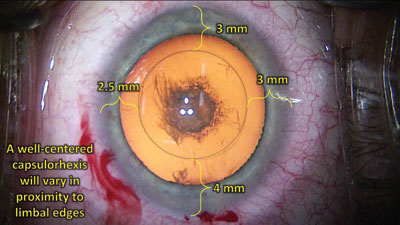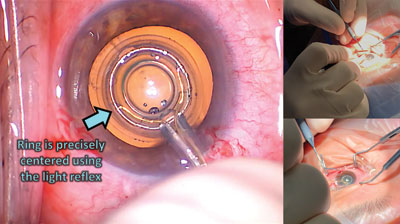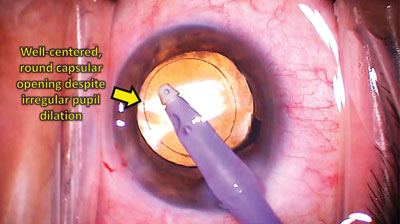Centration of capsulorrhexis an important part of cataract surgery
The Zepto device helps create a perfectly round anterior capsular opening, even in cases with irregular pupil dilation.
When performing cataract surgery, the capsulorrhexis is one of the most critical steps because it allows safe access to remove the nucleus and cortex and long-term stability for holding the IOL. A well-centered capsulorrhexis allows us to place the IOL in the center of the patient’s visual axis or pupillary axis, which can improve the performance of multifocal, extended depth of focus and even toric IOLs.
The central visual axis is not typically aligned with the center of the cornea or limbus. In addition, the pupil centration can change depending on the level of dilation or miosis. In order to accurately position the capsulorrhexis, we cannot rely on the distance from the capsular edge to the pupil or even the limbus (Figure 1). When doing cataract surgery under topical anesthesia, we can ask the patient to look at the microscope lights in order to place the Purkinje light reflections in the center of the visual axis. We can then use this as a reference point to create our capsulorrhexis of about 5 mm in diameter to hold the IOL optic, which is typically 6 mm in diameter.
A properly centered capsulorrhexis will be a round circle, but the corneolimbal junction is more ovoid in shape. This means that the distance from the capsular edge to the limbus varies from 2.5 mm (inferior) to 3 mm (nasal and superior) and even to 4 mm (temporal). Because of this, using the pupil as a guide for the capsulorrhexis creation is not ideal. In addition, patients can have different corneal diameters and even capsular bag sizes, although we tend to always use an IOL with a 6 mm optic diameter.

Source: Uday Devgan, MD
Creation of a well-centered capsulorrhexis is more difficult if the pupillary dilation is asymmetric. Making the capsulorrhexis can also be challenging in clinical situations such as pseudoexfoliation syndrome, trauma and other conditions in which zonular support is weak. And based upon my last 20 years of teaching cataract surgery to resident surgeons, the capsulorrhexis is one of the most difficult steps of surgery to master.
There are devices such as femtosecond lasers that can be used to create a well-centered and precisely sized anterior capsular opening. But the additional expense can be considerable, with lasers costing hundreds of thousands of dollars and substantial per-use fees. A recently approved device provides an alternative that is equally accurate and safe at just a fraction of the cost. The Zepto device from Mynosys Cellular Devices uses an electrical multi-pulse discharge to create a perfectly round 5.2-mm anterior capsular opening in just 0.004 seconds. I have used this device on many patients and am impressed with the precision and ease of use (Figure 2).

The device consists of a nitinol ring that can be compressed so that it fits in a 2.2-mm phaco incision. This is then opened in the eye using a fingertip control and placed on top of the anterior lens capsule. The device also contains a suction cup made of clear plastic to facilitate visualization for the surgeon. The center of the Zepto device is then aligned with the Purkinje light reflex, and the suction is applied. Next, the device is activated, and in just 4 milliseconds, micropulses of electrical energy are used to create a consistent and perfectly circular 5.2-mm anterior capsulotomy. The edges of this capsular opening are particularly strong, and experimental testing has shown them to surpass the strength of a femtosecond laser-made capsulotomy.

The anterior capsular opening is just one step of cataract surgery, but it is a critical one. Having the ability to consistently create a precise, well-centered and strong capsulotomy or capsulorrhexis is important to the success of the surgery. An intact capsulorrhexis makes the complication rate less and the optic position more secure and predictable. Take your time with this step of surgery and try the newer technologies to see where they can fit in your practice. Particularly in cases in which there is irregular dilation (Figure 3) or weaker zonular support, you will find that new devices such as the Zepto can make a real improvement. Finally, for the young surgeons in training, we encourage you to still develop your manual techniques and improve your surgical dexterity, but also make sure you get exposure to new technologies that have an ability to make cataract surgery even better and more precise.
- For more information:
- Uday Devgan, MD, is in private practice at Devgan Eye Surgery, Chief of Ophthalmology at Olive View UCLA Medical Center and Clinical Professor of Ophthalmology at the Jules Stein Eye Institute, UCLA School of Medicine. He can be reached at 11600 Wilshire Blvd. #200, Los Angeles, CA 90025; email: devgan@gmail.com; website: www.CataractCoach.com.
Disclosure: Devgan reports he is a paid consultant to Mynosys Cellular Devices.
